Your solution for Functional Electrical Stimulation


2
RehaMove at a glance
FES training with RehaMove
Active training despite complete or incomplete paralysis

FES Cycling with RehaMove Training modes and training templates
RehaMove in early rehabilitation
Active training from bed or therapy chair
Verticalization with robotic leg movement and FES
Medical exoskeleton with FES
Versatile robotic gait training with FES
3 Content
Functional Electrical Stimulation
RehaMove3
Studies Testimonials Global RehaMove Distribution Partners 4 6 8
20 26 28 34 36
RehaMove Sequence Training Sequenz Training for physical therapists Sequence Training for occupational therapists
FES for scientific purposes ScienceMode for FES research & development
16
Functional electrical stimulation (FES) is a therapy method where nerves are stimulated with electrical current via surface electrodes in order to cause muscular contraction. The aim is to produce a functional movement for impaired extremities.
FES can enable muscles to be trained even if some or all voluntary control of them has been lost. Additionally, FES can support volitional muscle control to complete a functional movement or to facilitate activities of daily living. The use of FES is scientifically proven for the following purposes:
• Relaxation of muscle spasms
• Prevention or retardation of disuse atrophy
• Increasing local blood circulation
• Maintaining or increasing range of motion

4
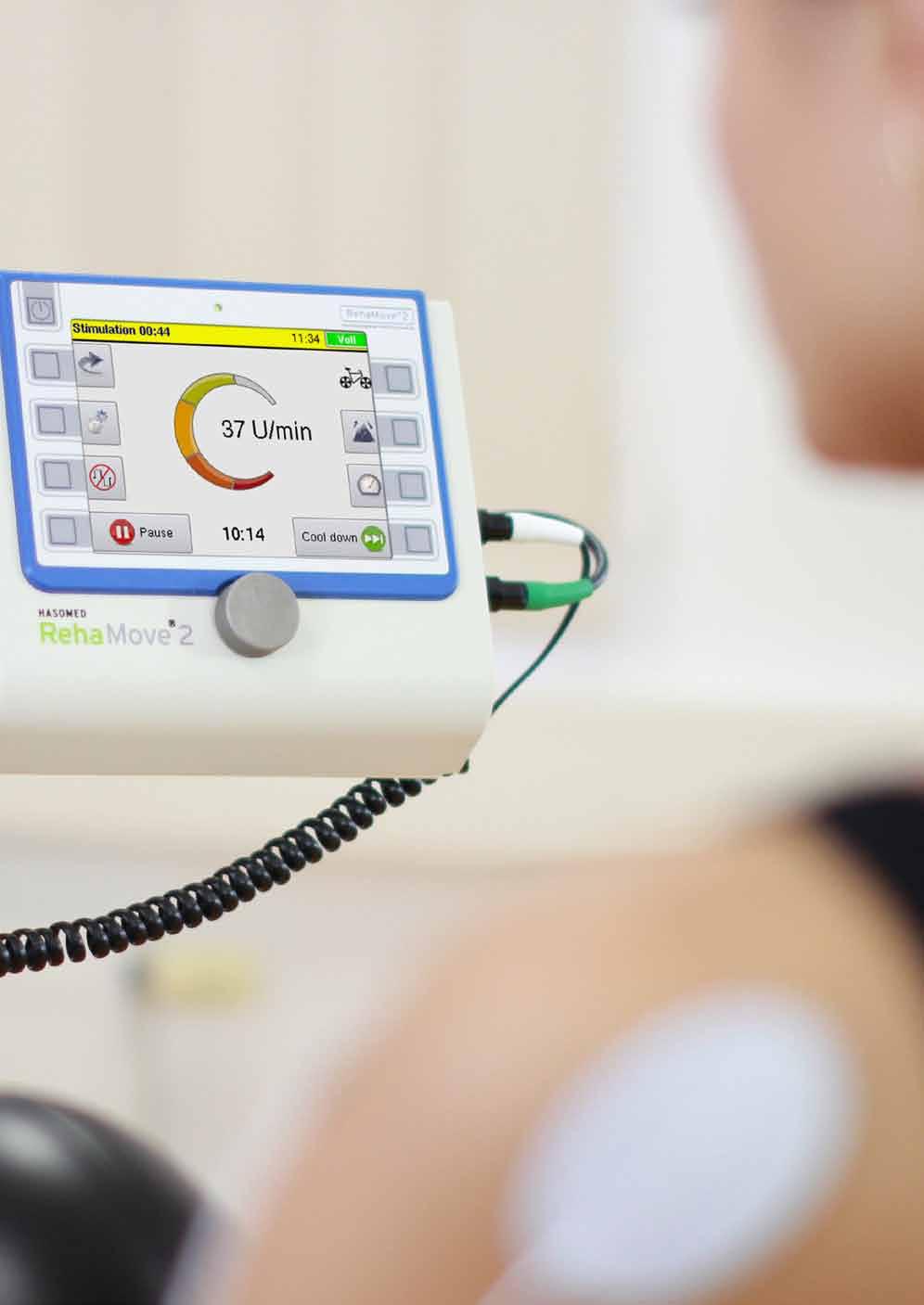
RehaMove at a glance
RehaMove is a portable electrical stimulation device that generates impulses on up to 8 channels simultaneously to activate impaired/paralyzed muscles via surface electrodes.

In addition, the stimulator software and hardware is especially designed for use in a specific rehabilitation system using an ergometer for FES Cycling.
8 Stimulation channels
Frequency 1-50 Hz
Pulse width 10-500 µs
Amplitude 1-130 mA
6
RehaMove leg training
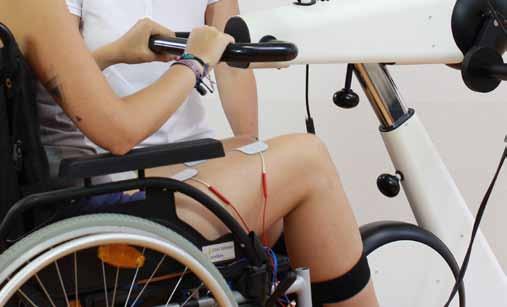
RehaMove arm training

RehaMove Sequence training


7
RehaMove benefits
Wide range of indications
Using RehaMove is indicated in neurological patients. Neurological disorders include:
· Stroke
Spinal cord injury (SCI)
Traumatic brain injury (TBI)
Parkinson’s disease
· Multiple sclerosis (MS)
User friendly
A big graphical display makes it easy to interact with the device. The operation of the device happens via pressure-sensitive buttons and a rotary switch.
Individual
Numerous parameters concerning power and temporal sequence of the impulses can be adjusted individually for each channel. The integrated database offers to save hundreds of individual training profiles.
Flexibility
The stimulator can generally be applied to functional electrical stimulation tasks of all kinds. RehaMove is designed as portable (contains a battery) as well as stationary device for training and rehabilitation applications. It can be used on its own or in combination with a motion trainer.
Safety first
Tapping [Stop] on the screen or pressing the Quick-Stop button stops the movement and stimulation immediately in events when the patient feels unwell during a training session. An electrode error detection function stops the device in case of faulty electrodes or other errors.

Made in Germany
The RehaStim2 stimulator is made in Germany and certified according to the international standards EN 60601-1 and EN 60601-2-10 for medical technical devices and systems.
8

Active arm or leg training despite complete or incomplete paralysis
FES Cycling enables active arm or leg ergometer training even with impaired muscles. The effective and feasible outcome parameters depend on individual constitutions and disorders of each user. In either situation, the user can create multiple stimulation programs and track performance gains over time Performance data can be viewed on the device or exported for viewing with RehaMove Windows software.
Active movement training
• Physiological muscle activation with high training intensity
• Strong effects on the cardiovascular system by using the major muscles of the body
• neuronal input by stimulating a big number of afferences
• Severe venous reflux
• Cosmetic aspects: muscle buildup
• Physiological effect: patients can “use” their arms and legs again


Passive movement training
• Passive movement of paralysed muscles with low or no physiological activation for complete or incomplete paralyzed limbs
10
MOTOmed muvi RehaMove stimulator
Your FES training with RehaMove
RehaMove FES Cycling Active movement therapy


Upgrade your MOTOmed with FES
RehaMove and MOTOmed communicate via a data cable which allows data exchange of all relevant parameters (angle or position of the crank arm, rpm and rotational direction, symmetry, gear, time, distance). Stimulation sequences of controlled channels are triggered by anglebased MOTOmed data. Thus, the stimulator “knows” the right stimulation time of each muscle.
M. quadriceps femoris
M. gluteus maximus
M. biceps femoris
M. tibialis anterior
M. gastrocnemius
11
90° 270° 180° 0° 360°

12
FES Cycling with RehaMove
Spinal Cord Injury
Guillain-Barré syndrom
Stroke
Parkinson‘s disease
Multiple Sclerosis
Traumatic Brain Injury
Cerebral Palsy
Improvement of the cardiovascular system
Mobility/range of motion of upper and lower extremities

Structural preservation of musculature
Function recovery of paretic muscles
Prevention of secondary diseases
13
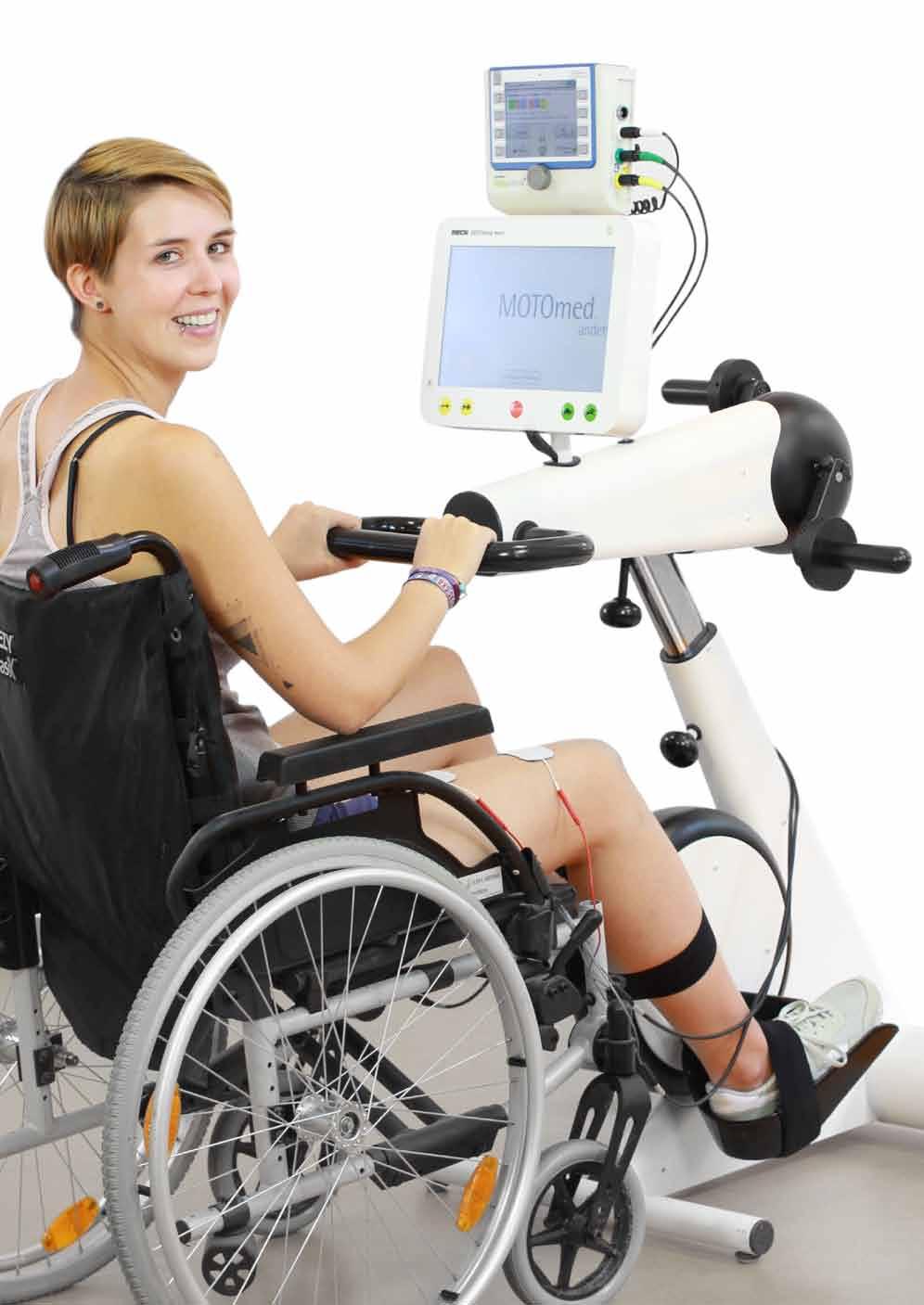
Training modes and Training templates
RehaMove offers a large number of stimulation templates for various applications. All templates are based on clinical studies and experiences, and provide different channel/muscle configurations paired with indication-specific parameter settings. For initial trainings, stimulation intensity should start low and be carefully increased to generate smooth and powerful contractions without pain or fast muscle fatigue.
In cases of spasticity, the use of lower frequency values (Hz) is indicated to avoid an excessive increase of muscle tone It’s advisable to massage muscles before training to desensitize them. Alternatively, a longer warm up phase is recommended. In cases of maintained sensitivity, the tolerance limit of the user should be the limit of stimulation (after a familiarization phase, intensity can generally be increased gradually).
HASOMED offers free Software-Updates for RehaMove.
Send your request to:
export@hasomed.de
Choose with your RehaMove between adaptive and constant training mode
Adaptive Mode
In adaptive mode, the current intensity adapts to the active rpm of the user.
Therapy goal: Support the residual muscle function of the user and adapt the stimulation depending on muscle fatigue.
Constant Mode
In constant mode, the current remains the same regardless of the active performance of the user.
Therapy goal: Active movement even with residual muscle function.
15
Stimulation
Stimulation
Patient performance
Patient performance
MOTOmed Letto2 may help to balance lack of movement in users confined to bed. Users can train actively from a bed or therapy chair. RehaMove combined with MOTOmed Letto2 provides well-rounded therapy to users in stationary care as well as at home.
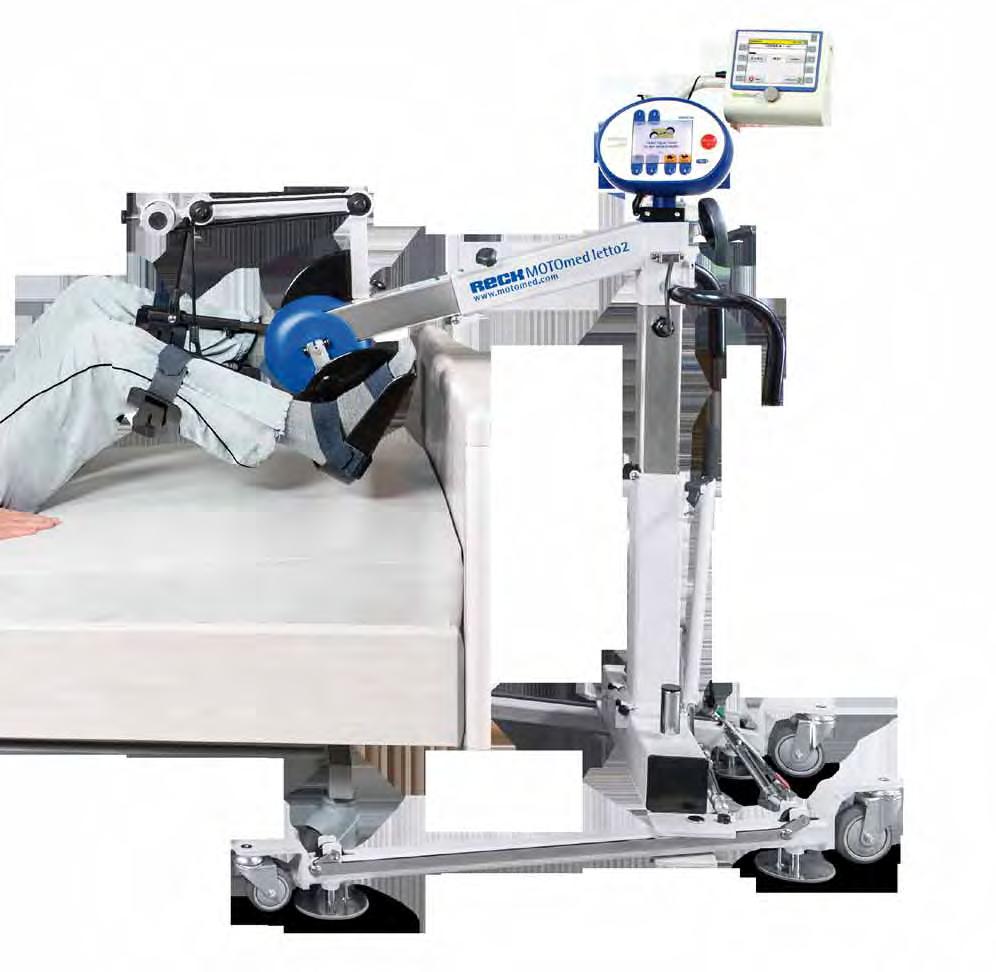
16
RehaMove in early rehabilitation
ErigoPro combines stepless verticalization with robotic leg movement and RehaMove´s functional electrical stimulation. With the ErigoPro, patients can be trained intensively and safely already at a very early stage of rehabilitation.
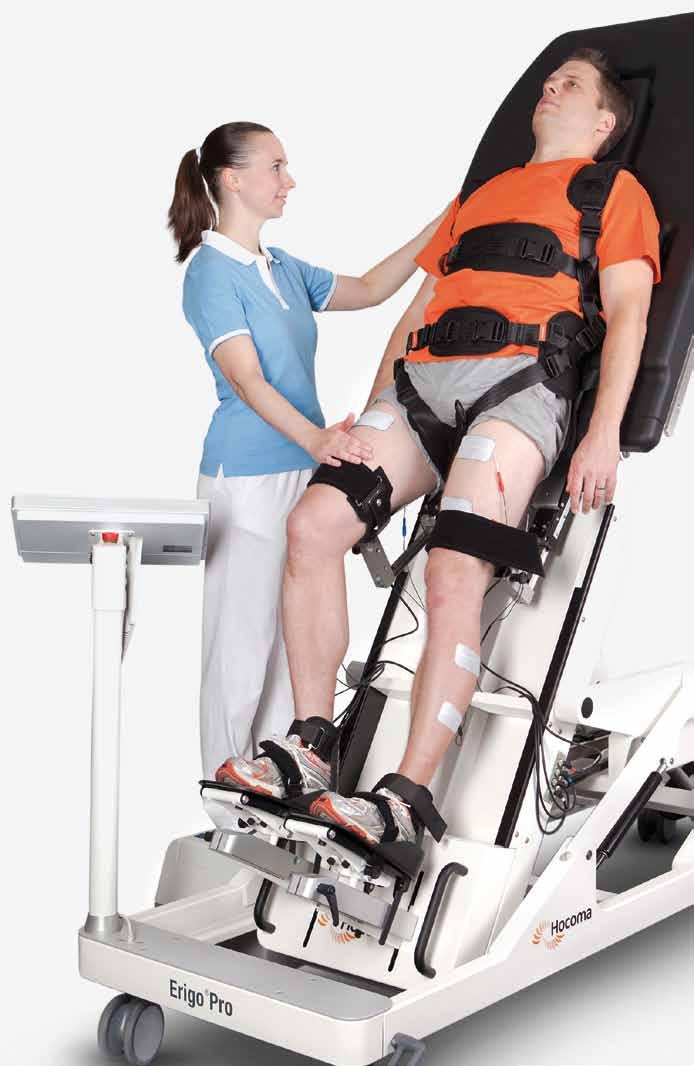
17
The combination of EksoGT medical exoskeleton and RehaMove functional electrical stimulation (FES) technology has demonstrated in research the benefit of a more versatile therapy. FES walking with a exoskeleton stimulates relevant muscles needed enhancing movement and gait training in rehabilitation.
The combination of exoskeleton technology with FES, gives clinicians the synergistic benefit of earlier mobility and muscle stimulation to provide rehabilitation to a broader spectrum of patients, ranging from preambulatory to almost independent.

18
RehaMove for robotic assisted training
The G-EO System is a versatile robotic gait trainer. Multiple different therapy options, such as partial movements, floor walking and the unique feature of realistically simulating climbing stairs, as well as the simple switch between passive, active-assistive and active mode allow for phase specific treatment of each individual patient throughout the whole continuum of care.
With the integration of RehaMove´s functional electrical stimulation (FES), the therapist is able to add supplementary muscle activation through multiple stimulation channels.

19
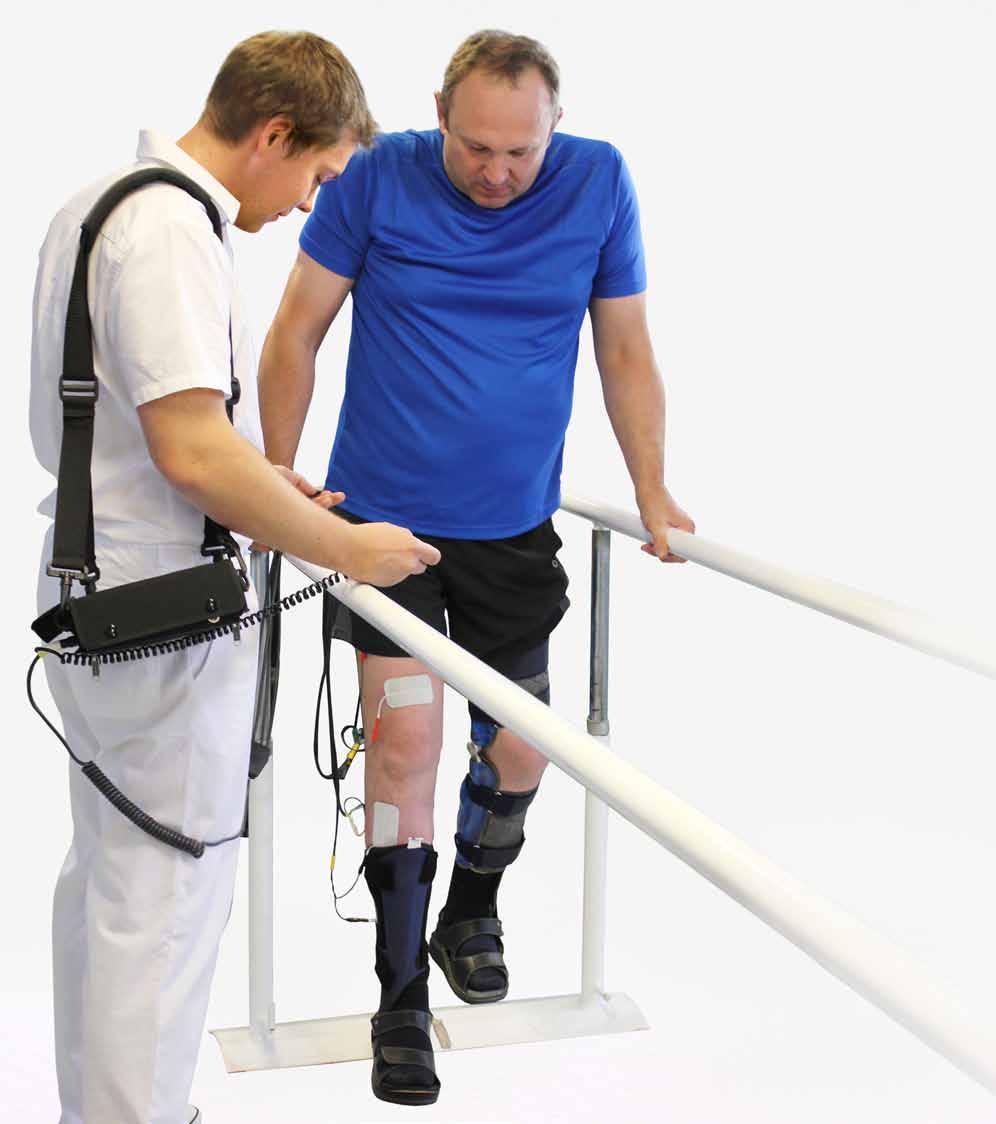
20
RehaMove Sequence Training
8 stimulation channels for various FES applications
RehaMove Sequence Training offers the stimulation of various functional movements, such as, 1-channel wrist extension up to 8-channel gait training. All stimulation channels can be individualized related to user and clinical needs. RehaMove Sequence Training can be activated via additional licenses for present stimulators. As well as for RehaMove FES Cycling, Sequence Training includes templates for the most common applications e.g. FES walking, crawling, sit-to-stand or shoulder stabilization.
Sequence Training for physical therapist‘s needs

In physical therapy, the focus is on motor initiation, training of atrophied muscles, general preservation of mobility and compensation of impaired/paralyzed muscles. Especially muscle atrophy can restrict therapy success extensively. With additional FES of the large (leg) muscles, an important contribution related to preservation of strength and mobility as well as improvements in motor skills can be ensured.
Sequence Training for occupational therapist‘s needs
After stroke or quadriplegia, upper extremity therapy can be a high priority. Missing motor or sensory functions can be recovered with high and frequent training efforts. FES increases the afferent and efferent input of the stimulated muscles and can help to support motor exercises and sensory recovery.
21
Sit to stand excercies
The most common physical deficit caused by a stroke is muscle weakness which limits a person’s mobility. Mobility encompasses activities necessary for daily functioning: getting in and out bed, on/off toilet, sitting, standing and walking. These activities are significantly affected in people with severe stroke who typically spend most of their time in bed or a chair and are immobile. Immobility is primarily caused by neurological damage but exacerbated by secondary changes in musculoskeletal and cardiorespiratory systems. These secondary changes can theoretically be prevented or minimised by early mobilisation. A combined FES training in early post-stroke rehabiliation can support the therapy progress.


22
with
without stimulation
stimulation
Sequence Training for physical therapists
Gait training
In general, gait is greatly altered for people who are affected by stroke. More than half of patients in the acute phase after stroke are not able to walk, and walking impairments are still present 3 months after stroke. Functional electrical stimulation has been shown to have therapeutic benefits in the early phase of gait rehabilitation, enabling patients with brain injuries to achieve a better functional result in a shorter period of time. Although FES and the use of a gait trainer have been separately demonstrated to have positive therapeutic effects in post-stroke rehabilitation.

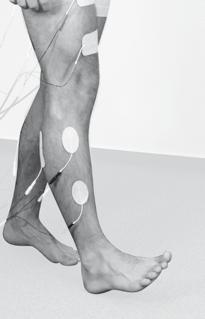






23 1 5 4 2 6 3 7
without
with
stimulation
stimulation
Wrist extension
Many individuals with stroke cannot open their affected hand in a functional way, but wrist extension is essential to carry out simple tasks in daily routines and having adequate strength is fundamental to these movements. These individuals either produce insufficient hand opening, or achieve hand opening while flexing their wrist. This can be improved by applying functional electrical stimulation (FES) to finger/thumb extensors.


without stimulation
with stimulation
24
Sequence Training for occupational therapists
Shoulder extension
Within the rehabilitation process, the use of FES is very important. Serveral studies have shown that FES therapy is effective for the activation of the shoulder stabilizing muscles, improving glenohumeral joint congruence, functional improvement and reduction of pain in patients with post-stroke glenohumeral subluxation.


25
without stimulation with stimulation
FES for scientific purposes
ScienceMode – central tool for FES research & development
The effect of Functional Electrical Stimulation (FES) is topic of scientific investigations worldwide. Research requires high performance stimulators with multiple options concerning individual adjustment and external control. Succeeding RehaStim1 and RehaStim2, HASOMED presents RehaMove3 – the 3rd generation within 15 years to satisfy clinical and research needs. The ScienceMode protocol for scientific FES applications was developed in close cooperation with Technical University of Berlin.
ScienceMode enables the communication between a PC or external device and the Stimulator wireless via Bluetooth or USB using an extensive protocol. The PC or external devices can control all stimulation tasks and measurements.

Performance
• 4 stimulation channels

• Frequency 1-500 Hz
• Pulse width 10 µs - 4 ms (1 µs steps) amplitude 0-150 mA (0,5 mA steps)
• Adjustable stimulation waveform (16 characteristic points)
• MatLab/Simulink library & pre-compiled library for several compiler (e.g. MSVC, GCC)
26
New Low-Level & Mid-Level communication protocol
RehaMove3 with ScienceMode offers advanced communication levels for superior scientific FES performance. The Low-level Layer allows explicit manipulation of every aspect of the stimulation waveform and the stimulation timing. Each stimulation impulse must be initiated by the control program, which enables individual non-periodic stimulation patterns. The Mid-level Layer implements a minimalistic command set with most common stimulation parameters. Corresponding stimulation commands are generated directly by the RehaMove3 with the favored stimulation frequency.
C-library for a simplified integration
Low- and Mid-level protocols were directly supported by a pre-compiled C-library. This library simplifies the integration in customer-specific applications or computer programming environments such as Matlab/Simulink, Scilab/Xcos or Python.
Free adjustable waveform

A new and important feature of RehaMove3 is the extensive level of control over the waveform, which can be illustrated by up to 16 characteristic points. Each point is defined by a duration and a current. Any number of waveforms can be created this way. The duration of each point can be chosen in 1 µs steps between 10 µs and 4095 µs. The current has a resolution of 0.5 mA and is limited to 150 mA at the highest setting.
Amplitude (1-130 mA)
For more Information, please call: +49 391 61 07 645
27
RehaMove3
Amplitude (1-130 mA) P1 P2 P3 CMD Duration P1 P2 P3 CMD Amplitude (1-130 mA) P1 P2 P3 CMD Duration P1 P2 P3
Duration Low-Level MID-Level
Studies
In recent years, various functional electrical stimulation (FES) techniques have been developed. The main goal was to provide alternative and efficient solutions for achieving the activities of daily living (ADLs) and to improve muscle function and physical fitness of paralyzed patients.

The applications can be divided into four areas: Stimulation of upper extremities, Standing, Walking, and Cycling.
RehaMove can be used for the main FES applications in all fields and has been applied in worldwide scientific projects for more than 10 years.
Your contribution is warmly welcomed for investigations regarding the effectiveness of FES with RehaMove. HASOMED will support research activities.
Support us with your ideas, projects, studies, and databases: export@hasomed.de
28
D. Kuhn, V. Leichtfried, W. Schobersberger, K. Röhl International Journal Rehabilitation Research 2014, Vol 37 No 3:243-250

BACkGROUND: An increasingly shorter inpatient stay accents the need for the best possible support and consequently the effectiveness of function-oriented physiotherapy. Predominantly in patients with spinal cord injury therapy devices may complement the intervention and therefore should be scientifically specified and further evaluated. Functional electrical stimulation could be such a complement; however, previous studies investigated only primarily measurable effects.

OBjECTIvE: This prospective cohort study evaluated the FES-cycling’s impact on functional abilities and performance parameters as well as the subjective pain and health perception of patients with spinal cord injury.
METHOD: 30 patients (13 with tetraplegia, 17 with paraplegia) participated in the FES-cycling programme. Before and after each session pain perception was assessed using the Numeric Rating Scale (NRS). In addition, activities of daily living (Spinal Cord Independence Measure III, SCIM III), health-related well-being (Short Form 36 Health Survey), and performance data of the leg ergometer were collected.
RESULTS: After 4 weeks’ training, the SCIM rose from 42 to 51 points (p = 0.004). The results of the SF-36 (subjective pain perception, vitality, mental well-being) improved significantly (p < 0.001). In Patients both with complete as well as incomplete paraplegia the average active performance (p = 0.035 vs. p = 0.002) and physical work (p = 0.025 vs. p = 0.001) increased significantly.
CONCLUSIONS: The results suggest that FES-cycling can support acute functional rehabilitation as well as motivation for continuing self-exercise in patients with spinal cord injury.
Functional electrical stimulation-assisted active cycling: therapeutic effects in patients with hemiparesis from 7 days to 6 months after stroke.
Bauer P, Krewer C, Golaszewski S, Koenig E, Müller F.; Arch Phys Med Rehabil. 2015 Feb;96(2):188-96
OBjECTIvE: To determine whether functional electrical stimulation (FES)-assisted active cycling is more effective than active cycling without FES concerning walking and balance. Specifically, walking ability was classified as to the amount of personal assistance needed to be able to walk and balance was evaluated for static and dynamic balance tasks.
METHOD: Monocentric, randomized, single-blinded, controlled trial. Patients with severe hemiparesis due to stroke (N=40). Twenty minutes of active leg cycling with or without FES applied to the paretic vastus medialis and rectus femoris of quadriceps and to the biceps femoris and semitendinosus muscles, 3 times/wk for 4 weeks.
RESULTS: After the intervention, the FAC, POMA, and the MI (P<.016) for both intervention groups improved significantly. The FAC of the control group increased by a median of 1 category and that of the FES group by 2 categories. The median change in POMA was 2 and 4 points for the control group and the FES group, respectively. The MannWhitney U test between-group comparisons revealed that these gains were significantly better in the FES group for both the FAC (U=90; z=-2.58; P=.013; r=-.42) and the POMA (U=60; z=-3.43; P<.0004; r=-.56).
CONCLUSIONS: FES-assisted active cycling seems to be a promising intervention during rehabilitation in patients with stroke.
29 SCI/FES Cycling, Germany Stroke/FES Cycling, Germany
Four weeks of functional electrical stimulated cycling after spinal cord injury: a clinical cohort study.
Studies
Apr;42(4):1068-73
OBjECTIvE: This study assessed whether cycling induced by functional electrical stimulation (FES) was more effective than passive cycling with placebo stimulation in promoting motor recovery and walking ability in postacute hemiparetic patients.
METHOD: In a double-blind, randomized, controlled trial, 35 patients were included and randomized to receive FES-induced cycling training or placebo FES cycling. The 4-week treatment consisted of 20 sessions lasting 25 minutes each. Primary outcome measures included the leg subscale of the Motricity Index and gait speed during a 50-meter walking test. Secondary outcomes were the Trunk Control Test, the Upright Motor Control Test, the mean work produced by the paretic leg, and the unbalance in mechanical work between paretic and nonparetic legs during voluntary pedaling.
RESULTS: Repeated-measures ANOVA (P<0.05) revealed significant increases in Motricity Index, Trunk Control Test, Upright Motor Control Test, gait speed, and mean work of the paretic leg after training and at follow-up assessments for FES-treated patients. A main effect favoring FES-treated patients was demonstrated by repeated-measures ANCOVA for Motricity Index (P<0.001), Trunk Control Test (P=0.001), Upright Motor Control Test (P=0.005), and pedaling unbalance (P=0.038)
CONCLUSIONS: The study demonstrated that 20 sessions of FES cycling training significantly improved lower extremity motor functions and accelerated the recovery of overground locomotion in postacute hemiparetic patients.
OBjECTIvE: To investigate short- and long-term benefits of 16 weeks of thrice-weekly multi-channel surface FES-assisted walking program, while ambulating on a body weight support treadmill and harness system, versus a non-FES exercise program, on improvements in gait and balance in individuals with chronic incomplete traumatic SCI, in a randomized controlled trial design.
METHOD: Individuals with traumatic and chronic (≥18 months) motor incomplete SCI (level C2 to T12, American Spinal Cord Injury Association Impairment Scale C or D) were recruited from an outpatient SCI rehabilitation hospital, and randomized to FES-assisted walking therapy (intervention group) or aerobic and resistance training program (control group). Outcomes were assessed at baseline, and after 4, 6, and 12 months. Gait, balance, spasticity, and functional measures were collected.

RESULTS: Spinal cord independence measure (SCIM) mobility sub-score improved over time in the intervention group compared with the control group (baseline/12 months: 17.27/21.33 vs. 19.09/17.36, respectively). On all other outcome measures the intervention and control groups had similar improvements. Irrespective of group allocation walking speed, endurance, and balance during ambulation all improved upon completion of therapy, and majority of participants retained these gains at long-term follow-ups.
CONCLUSIONS: Task-oriented training improves walking ability in individuals with incomplete SCI, even in the chronic stage. Further randomized controlled trials, involving a large number of participants are needed, to verify if FES-assisted treadmill training is superior to aerobic and strength training.

30 Stroke/FES Walking, Canada
Cycling induced by electrical stimulation improves motor recovery in postacute hemiparetic patients: a randomized controlled trial.
Ambrosini E, Ferrante S, Pedrocchi A, Ferrigno G, Molteni F. Stroke. 2011
A randomized trial of functional electrical stimulation for walking in incomplete spinal cord injury: Effects on walking competency.
Kapadia N, Masani K, Catharine Craven B, Giangregorio LM, Hitzig SL, Richards K, Popovic MR. J Spinal Cord Med. 2014 Sep;37(5):511-24
Stroke/FES Cycling, Italy
Lee HJ, Cho KH, Lee WH.
Am J Phys Med Rehabil. 2013 Dec;92(12):1051-9

OBjECTIvE: The aim of the current study was to examine the effect of body weight support treadmill training (BWSTT) with power-assisted functional electrical stimulation on functional movement and gait in stroke patients.
METHOD:Thirty stroke patients were randomly assigned to either the experimental group (n = 15) or the control group (n = 15). The experimental group participated in BWSTT with power-assisted functional electrical stimulation for 30 mins per day, five times a week, for 4 wks, and those in the control group participated in BWSTT for 30 minutes per day, five times a week, for 4 wks. Functional movement was assessed using the Berg Balance Scale, the Timed Up and Go test, and the Stroke Rehabilitation Assessment of Movement. Gait ability was assessed using an electrical walkway system.
RESULTS: Significant differences in the time factor for functional movement and gait (P < 0.05) were observed in the experimental and control groups. For the group × time interaction, significant improvements were observed in the functional movement (Berg Balance Scale [10.93 vs. 6.00], Timed Up and Go test [-9.25 vs. -5.25 secs], and Stroke Rehabilitation Assessment of Movement scores [14.07 vs. 9.80]) and gait (velocity [40.07 vs. 18.64 cm/ sec], cadence [30.57 vs. 17.75 steps per minute], paretic side step length [19.36 vs. 8.46 cm], and stride length [30.57 vs. 12.71 cm]) (P < 0.05).
CONCLUSIONS: The findings of the current study demonstrated the efficacy of BWSTT with power-assisted functional electrical stimulation on the functional movement and gait ability in stroke patients. Therefore, the authors suggest that power-assisted functional electrical stimulation may be an effective method for the improvement of functional movement and gait ability of stroke patients when added to BWSTT.
Changes in pulmonary function measures following a passive abdominal functional electrical stimulation training program.
2013 Mar;36(2):97-103
OBjECTIvE: To demonstrate the effect of a passive abdominal functional electrical stimulation (AFES) training program on unassisted respiratory measures in tetraplegia.

METHOD: Twelve patients with tetraplegic spinal cord injury, who could breathe independently, with reduced vital capacity and no visible abdominal movement. Three weeks of abdominal muscle conditioning using transcutaneous AFES. The increase in FVC over the training period and the absence of change before or after training suggest that passive abdominal FES training can be used for respiratory rehabilitation in tetraplegia.
RESULTS: Mean (SD) FVC increased by 0.36 l (0.23) during training (P = 0.0027). Mean (SD) FEV1 and PEF tended to increase by 0.18 l (0.16) and 0.39 l/seconds (0.35), respectively, but this was not significant. No significant change was found in the outcome measures during a 1-week pre-training control phase and during a 3-week post-training phase
CONCLUSIONS: The increase in FVC over the training period and the absence of change before or after training suggest that passive abdominal FES training can be used for respiratory rehabilitation in tetraplegia.
31 Stroke/FES Walking, South k or ea SCI/FES Breathing, Scotland
The effects of body weight support treadmill training with power-assisted functional electrical stimulation on functional movement and gait in stroke patients.
Studies
McLachlan AJ, McLean AN, Allan DB, Gollee H. J Spinal Cord Med.
Contralaterally Controlled Functional Electrical Stimulation Improves Hand Dexterity in Chronic Hemiparesis.
Knutson JS, Gunzler DD, Wilson RD, Chae J Stroke. 2016 Oct;47(10):2596-602.
OBjECTIvE: It is unknown whether one method of neuromuscular electrical stimulation for poststroke upper limb rehabilitation is more effective than another. Our aim was to compare the effects of contralaterally controlled functional electrical stimulation (CCFES) with cyclic neuromuscular electrical stimulation (cNMES).

METHOD: Stroke patients with chronic (>6 months) moderate to severe upper extremity hemiparesis (n=80) were randomized to receive 10 sessions/wk of CCFES- or cNMES-assisted hand opening exercise at home plus 20 sessions of functional task practice in the laboratory for 12 weeks. The task practice for the CCFES group was stimulation assisted. The primary outcome was change in Box and Block Test (BBT) score at 6 months post treatment. Upper extremity Fugl-Meyer and Arm Motor Abilities Test were also measured.

RESULTS: At 6 months post treatment, the CCFES group had greater improvement on the BBT, 4.6 (95% confidence interval [CI], 2.2-7.0), than the cNMES group, 1.8 (95% CI, 0.6-3.0), between-group difference of 2.8 (95% CI, 0.1-5.5), P=0.045. No significant between-group difference was found for the upper extremity Fugl-Meyer (P=0.888) or Arm Motor Abilities Test (P=0.096). Participants who had the largest improvements on BBT were <2 years post stroke with moderate (ie, not severe) hand impairment at baseline. Among these, the 6-month post-treatment BBT gains of the CCFES group, 9.6 (95% CI, 5.6-13.6), were greater than those of the cNMES group, 4.1 (95% CI, 1.7-6.5), between-group difference of 5.5 (95% CI, 0.8-10.2), P=0.023
CONCLUSIONS: CCFES improved hand dexterity more than cNMES in chronic stroke survivors.
OBjECTIvE: Robot-assisted therapy (RT) is a widely used intervention approach to enhance motor recovery in patients after stroke, but its effects on functional improvement remained uncertain. Neuromuscular electrical stimulation (NMES) is one potential adjuvant intervention approach to RT that could directly activate the stimulated muscles and improve functional use of the paretic hand.
METHOD: This was a randomized, double-blind, sham-controlled study. Thirty-nine individuals with chronic stroke were randomly assigned to the RT combined with NMES (RT + ES) or to RT with sham stimulation (RT + Sham) groups. The participants completed the intervention 90 to 100 minutes/day, 5 days/week for 4 weeks. The outcome measures included the upper extremity Fugl-Meyer Assessment (UE-FMA), modified Ashworth scale (MAS), Wolf Motor Function Test (WMFT), Motor Activity Log (MAL), and Stroke Impact Scale 3.0 (SIS). All outcome measures were assessed before and after intervention, and the UE-FMA, MAL, and SIS were reassessed at 3 months of follow-up.
RESULTS: Compared with the RT + Sham group, the RT + ES group demonstrated greater improvements in wrist flexor MAS score, WMFT quality of movement, and the hand function domain of the SIS. For other outcome measures, both groups improved significantly after the interventions, but no group differences were found.
CONCLUSIONS: RT + ES induced significant benefits in reducing wrist flexor spasticity and in hand movement quality in patients with chronic stroke.
32 SCI/FES Arm Cycling, USA Stroke/FES Upper Extremities, Taiwan
Effects of combining robot-assisted therapy with neuromuscular electrical stimulation on motor impairment, motor and daily function, and quality of life in patients with chronic stroke.
Lee YY, Lin KC, Cheng HJ, Wu CY, Hsieh YW, Chen CK. J Neuroeng Rehabil. 2015 Oct 31;12:96
Cooperative hand movements in post-stroke subjects: Neural reorganization.
Schrafl-Altermatt M, Dietz V. Clin Neurophysiol. 2016 Jan;127(1):748-54.

OBjECTIvE: Recent research indicates a task-specific neural coupling controlling cooperative hand movements reflected in bilateral electromyographic reflex responses in arm muscles following unilateral nerve stimulation. Reorganization of this mechanism was explored in post-stroke patients in this study.
METHOD: Electromyographic reflex responses in forearm muscles to unilateral electrical ulnar nerve stimulation were examined during cooperative and non-cooperative hand movements.
RESULTS: Stimulation of the unaffected arm during cooperative hand movements led to electromyographic responses in bilateral forearm muscles, similar to those seen in healthy subjects, while stimulation of the affected side was followed only by ipsilateral responses. No contralateral reflex responses could be evoked in severely affected patients. The presence of contralateral responses correlated with the clinical motor impairment as assessed by the Fugl-Meyer test.
CONCLUSIONS: The observations suggest that after stroke an impaired processing of afferent input from the affected side leads to a defective neural coupling and is associated with a greater involvement of fiber tracts from the unaffected hemisphere during cooperative hand movements.
Coordinating Upper and Lower Body During FES-Assisted Transfers in Persons With Spinal Cord Injury in Order to Reduce Arm Support.
Jovic J, Azevedo Coste C, Fraisse P, Henkous S, Fattal C. Neuromodulation. 2015 Dec;18(8):736-43

OBjECTIvE: The goal of this study is to minimize arm forces applied during sit-to-stand (STS) transfers in persons with spinal cord injury (SCI) by using functional electrical stimulation (FES) applied to lower limbs muscles.
METHOD:Six participants with chronic SCI participated in the study Participants with SCI were recruited to complete STS movement using a new system for FES-assisted STS transfer. All participants attended one muscle mapping session to test their muscles condition, two training sessions to become familiarized with the experimental setup, and two measurement sessions using the proposed system for FES-assisted STS movement. The applied arm forces during STS movement were recorded and analyzed for different stimulation onset values with respect to the maximal trunk acceleration signal using one-way ANOVA statistical test. Post-hoc analysis was performed using Tukey‘s method.
RESULTS: The results of this study showed that the moment of the stimulation onset has an influence on the arm forces applied during the STS motion. The lowest values of arm forces were obtained for STS movements where the electrical stimulation was triggered before and around the time corresponding to the maximal value of the trunk acceleration signal.
CONCLUSIONS: Lowest arm forces values were obtained for STS motions that were similar to those of healthy persons in terms of trunk movements and beginning of lower limb movements in regards to maximal trunk acceleration signal. The FES system was able to mimic the rising motion of a healthy individual by triggering the FES at the appropriate moment. This method could prove useful for pivot transfer, therapeutic or functional verticalization.
33 Stroke/FES Upper Extremities, Switzerland
SCI/FES Sit to Stand, France Studies
BGU Murnau Spinal Cord Injury Center, Physiotherapy Department
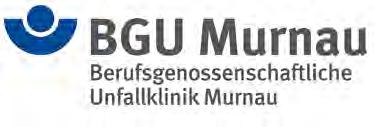
“We apply RehaMove for patients with incomplete spinal cord injury (AIS C) from C4 to L5. The main therapy goal is to support and strengthen existing motor functions, muscle force and endurance. The treatment requires intact lower motor neurons of the stimulated muscles and the FES compliance of each single patient. FES Cycling with RehaMove is recommended as home therapy to support the pre-clinical rehabilitation concerning a focused activation and increasing of muscle performance.”
Asklepios Neurological Clinic Falkenstein Clinic for Neurology and neurological Rehabilitation

“Generally our patients get treated twice a week with this effective therapy form. RehaMove is characterized with a smart usability and simple patient data management. This offers an independent home usage after the clinical treatment. Particularly patients after stroke get treated with RehaMove in addition to their conventional therapy to improve functions and mobility of paralyzed lower limbs.”
MEDIAN Clinic Magdeburg Neurological Rehabilitation Center

“RehaMove primarily shows [...] quick effects regarding increasing coordination skills of paralyzed patients. This generates positive impressions for persons concerned and supports the effectiveness of their own effort in the accompanying therapy. Consequently, the overall impression of the application is positive throughout following usability and feedback of patients.”
Westerwald clinic Waldbreitbach Rehabilitation Center for Neurology
“FES Cycling is mainly used for patients with neurological disorders and paresis after stroke, multiple sclerosis or polyneuropathy. FES with RehaMove is a meaningful addition to our physiotherapy due to its functional activation and effective tonus regulation of paralyzed muscles. Comparing with single-muscle activation of many common electrical stimulators, RehaMove offers an individual configuration and manual triggering of up to eight channels which allows the stimulation of movements similar to daily activities.”

34
Testimonials
Swiss Paraplegig Center

Department of Therapy Management
“FES with RehaMove is applied for patients with complete or incomplete spinal cord injury (AIS A-C). Regulation of muscle tone, decreasing of spasticity and cardiovascular training are main therapy goals for the treatment of complete SCIs. Patients with incomplete paraplegia or quadriplegia use FES to improve deep sensation for relaxation of muscle spasms and endurance training. Therapists can pre-set training parameters for an easy application as home therapy.”

Heidelberg University Hospital

Spinal Cord Injury Center at the Department of Orthopedics
“FES Cycling is an evidence-based therapy for patients with complete or incomplete spinal cord injury RehaMove is used as part of our clinical routine to reduce spasticity of patients with spastic paraplegia or quadriplegia. If continuously and frequently applied, spasmolytic medication can be reduced. In addition, we use FES Cycling for further indications like cardiovascular training.”
BG Clinic Halle
Spinal Cord Injury Center and Clinic for Orthopedics
“Patients with motor and sensory complete spinal cord injuries as well as incomplete ones get treated with RehaMove FES. One of the most problematic secondary diseases following a spinal cord injury is spasticity. FES Cycling influences spastic hypertonicity positively and local blood flow of our treated patients improves significantly. Particularly, preventing thrombosis is one of our therapy goals which we can achieve with the support of FES.”
Mittelbayrisches Rehabilitationszentrum
klinik Maximilian - Clinic for Neurology
“Experiences of daily use show that FES Cycling is a helpful intervention to increase a self-dependence life of people with neurological impairments. Primarily, patients with disorders of the central nervous system can profit by FES Cycling additionally or after the clinical treatment. Astonishingly, patients with neglect after stroke show significant improvements of their perception and motor functions during walking exercises.”

35
EUROPE
Belgium
Arseus Medical www.arseus-medical.be
Procare BV www.procarebv.nl
Czech Republic
BTL zdravotnická technika, a.s. www.btl.cz
Denmark
ProTerapi A/S www.proterapi.dk
Finnland
Haltija Group Oy www.haltija.fi
France Mobile France Sarl www.mobilefrance.fr
Gibraltar Rock Fitness rockfitness@live.co.uk
Greece
Ostracon www.ostraconmed.com
Hungary Graphinisus Kft. www.graphinisus.hu
Italy
E.M.S. s.r.l. www.emsmedical.net
Lithuania
Medlinkas UAB www.medlink.lt
Latvia
SIA Baltmedika www.baltmedika.lv
Netherlands
Connected by Power info@connectedbypower.nl
Poland
POLOmed www.polomed.pl
Romania
Rozani Kraft S.R.L. rozanikraft@gmail.com
Russia STM Medical www.motomed.ru
Slovenia/Croatia Larus Inventa d.o.o. www.rehacom.si
Spain
AIDMOVING www.aidmoving.com
United Kingdom
Anatomical Concepts (UK) Ltd. www.anatomicalconcepts.com
Ireland
Lyncare Ltd www.lyncare.ie
Island Eirberg ehf. www.eirberg.is
Sweden IntraMedic AB www.intramedic.se
Switzerland
Rehabilitations-Systeme AG www.rehasys.ch
NEAR & MIDDLE EAST
Bangladesh Babel Corporation Ltd. sales@babel.com.bd
India
Hospimedica International Pvt. Ltd. www.hospimedicaintl.com
Iran
DAJ Scientific Group www.daj-scientific.com
Israel
Bepex Ltd. www.bepex.co.il
Lebanon Intercare sarl mfd@intercare-sarl.com
Saudi Arabia Care Techniques www.caretechniques.com
Shams Al-Riyadh for Trading est. www.shams-alriyadh.com
Qatar
DYNAMIC MEDICAL SUPPLIES LLC info@dmsqa.com
Turkey
Destek Rehabilitasyon Teknolojileri Ltd. Sti. www.engelsiz.tel
United Arab Emirates JKR INTERNATIONAL L.L.C www.jkrintl.com
Modern Pharmaceutical Co. www.mpchealthcare.com
Africa
South Africa Mediotronics Physical Medicine (Pty) Ltd. www.mediotronics.co.za
36
Global RehaMove Distribution Partner
AUSTRALIA
NSW: Mobility Wholesale Distributors Pty Ltd www.mwd.com.au
QLD: THINK MOBILITY PTY LTD www.thinkmobility.com.au
VIC: Trek Mobility P/L. www.trekmobility.com.au
SA: Xtracare Equipment trading www.xtracareequipment.com.au
NEW ZEALAND
Acutech Electronics Ltd. www.acutech.co.nz
NORTH AMERICA
Canada
Atlas Medic Inc. www.atlasmedic.com
USA
Enable Me www. enableme.com
SOUTH AMERICA
Argentina
Arraya Equipamiento Medico www.arrayamed.com.ar
Brazil
APX Group www.apxgroup.com.br
Chile
Doctor‘s Choice Ltda www.doctorchoice.cl
Colombia Invivo Bioingenieria www.invivo.com.co
Mexico
MedRent S.A. de C.V. www.med-rent.com
ASIA
China
JingLai International Trade Co. Ltd. www.jinglaitrade.com/en
Hong Kong
Janley Limited
www.janley.com.hk
Malaysia IDS Medical Systems (M) Sdn Bhd www.idsmed.com
South Korea
HOSPI Co., Ltd.
www.hospi.co.kr
Singapore
Optimal Medical Products Pte. Ltd.
www.optimalmedical.com.sg
Taiwan
Continuous Instrument Co., Ltd. www.continuous.com.tw
37
38 Notes
Imprint
HASOMED GmbH
Paul-Ecke-Str. 1
39114 Magdeburg
Germany
T: +49 391 6230-112
F: +49 391 6230-113
M: info@hasomed.com
W: www.hasomed.com
Publisher: HASOMED GmbH
Pictures: HASOMED GmbH, Fotolia, iStockphoto
Print: WIRmachenDRUCK GmbH
Copyright: HASOMED GmbH 2019
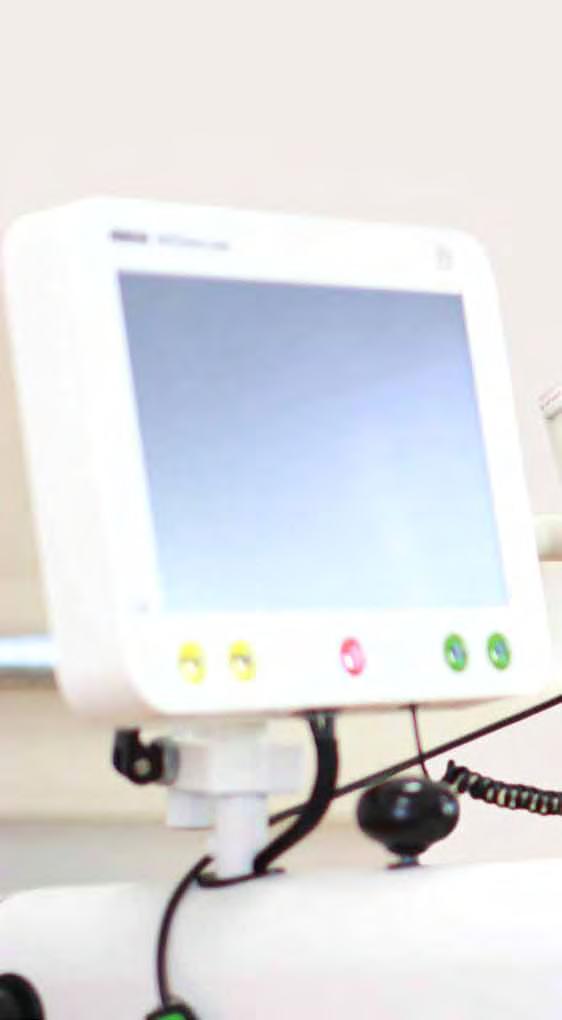
HASOMED GmbH Paul-Ecke-Str. 1 D-39114 Magdeburg +49 391 6107 645 export@hasomed.de www.hasomed.com Ver. 2019-03




















































